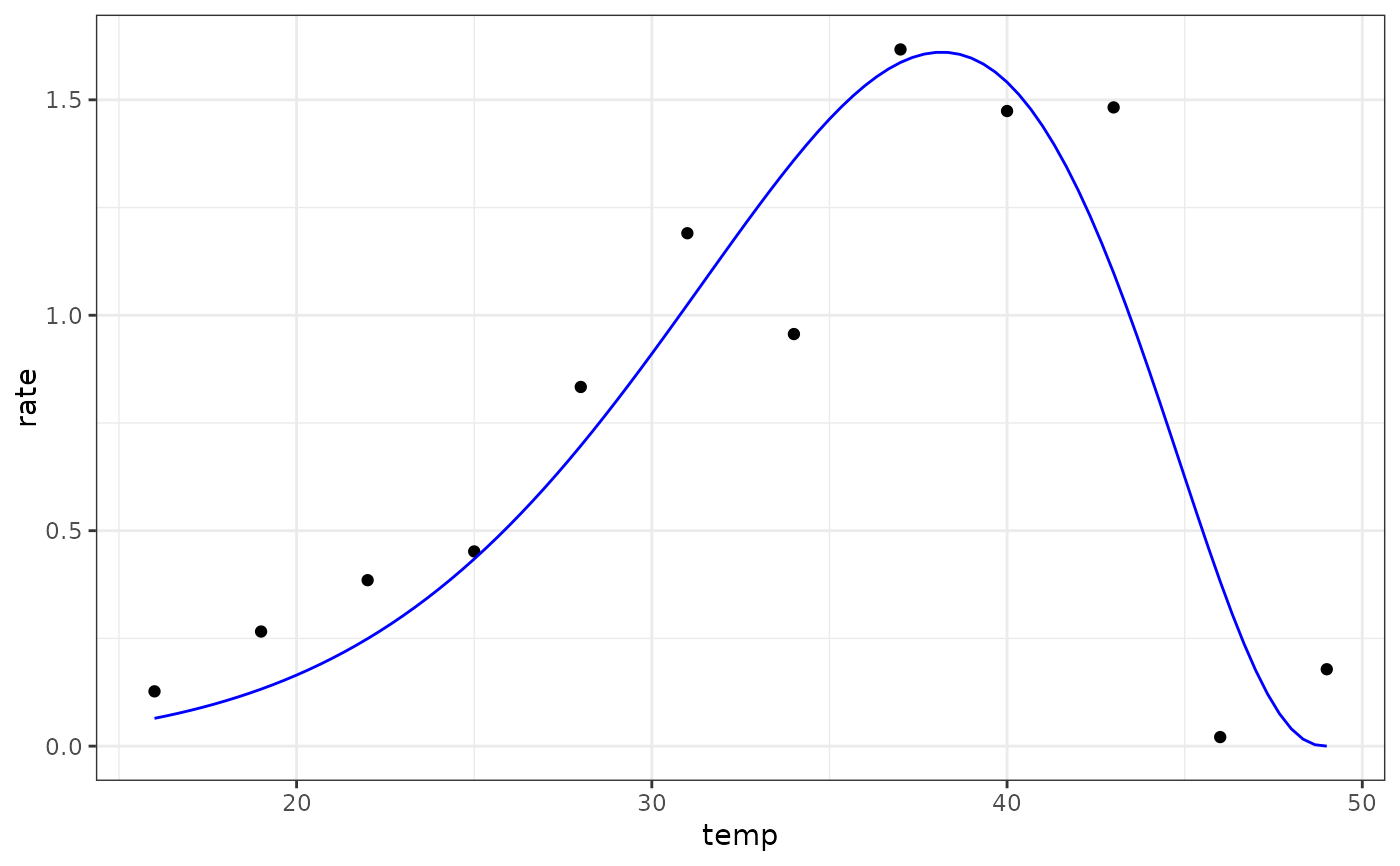
Extended Brière model for fitting thermal performance curves
Source:R/briereextended_2021.R
briereextended_2021.RdExtended Brière model for fitting thermal performance curves
Arguments
- temp
temperature in degrees centigrade
- tmin
low temperature (ºC) at which rates become negative
- tmax
high temperature (ºC) at which rates become negative
- a
scale parameter to adjust maximum rate of the curve
- b
shape parameter to adjust the asymmetry of the curve
- d
shape parameter to adjust the asymmetry of the curve
Value
a numeric vector of rate values based on the temperatures and parameter values provided to the function
Details
Equation: $$rate=a \cdot temp \cdot (temp - t_{min})^b \cdot (t_{max} - temp)^d$$
Start values in get_start_vals are derived from the data or sensible values from the literature.
Limits in get_lower_lims and get_upper_lims are derived from the data or based extreme values that are unlikely to occur in ecological settings.
References
Cruz-Loya, M. et al. Antibiotics shift the temperature response curve of Escherichia coli growth. mSystems 6, e00228–21 (2021).
Examples
# load in ggplot
library(ggplot2)
# subset for the first TPC curve
data('chlorella_tpc')
d <- subset(chlorella_tpc, curve_id == 1)
# get start values and fit model
start_vals <- get_start_vals(d$temp, d$rate, model_name = 'briereextended_2021')
# fit model
mod <- nls.multstart::nls_multstart(rate~briereextended_2021(temp = temp, tmin, tmax, a, b, d),
data = d,
iter = c(4,4,4,4,4),
start_lower = start_vals - 10,
start_upper = start_vals + 10,
lower = get_lower_lims(d$temp, d$rate, model_name = 'briereextended_2021'),
upper = get_upper_lims(d$temp, d$rate, model_name = 'briereextended_2021'),
supp_errors = 'Y',
convergence_count = FALSE)
# look at model fit
summary(mod)
#>
#> Formula: rate ~ briereextended_2021(temp = temp, tmin, tmax, a, b, d)
#>
#> Parameters:
#> Estimate Std. Error t value Pr(>|t|)
#> tmin -4.728e+01 7.734e+02 -0.061 0.95296
#> tmax 4.900e+01 1.057e+01 4.634 0.00239 **
#> a 5.624e-37 5.821e-34 0.001 0.99926
#> b 1.676e+01 1.942e+02 0.086 0.93361
#> d 2.411e+00 7.873e+00 0.306 0.76836
#> ---
#> Signif. codes: 0 ‘***’ 0.001 ‘**’ 0.01 ‘*’ 0.05 ‘.’ 0.1 ‘ ’ 1
#>
#> Residual standard error: 0.2841 on 7 degrees of freedom
#>
#> Number of iterations to convergence: 57
#> Achieved convergence tolerance: 1.49e-08
#>
# get predictions
preds <- data.frame(temp = seq(min(d$temp), max(d$temp), length.out = 100))
preds <- broom::augment(mod, newdata = preds)
# plot
ggplot(preds) +
geom_point(aes(temp, rate), d) +
geom_line(aes(temp, .fitted), col = 'blue') +
theme_bw()
